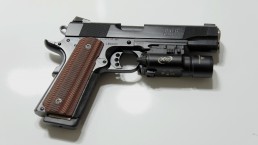Day: December 30, 2014
Buyer's Guide to the 1911
Welcome to our buyer's guide to the 1911. If you're not interested in a long winded in-depth guide and just want an immediate and basic recommendation, buy an $650-$1200 pistol chambered in .45 ACP with a Government length (5”) barrel from Springfield Armory, Colt, Smith & Wesson, SIG Sauer, Ruger, or Remington. The decision between each of those models and manufacturers will come down to price and preference.
History
For the uninitiated, the M1911 pistol has been in continuous service with the United States Armed Forces since the year 1911 (hence the name), when it beat out the Luger pistol chambered in 9x19mm Parabellum for the initial contract. It has provided over one hundred years of continuous service internationally to date, and by the looks of things, it will continue to do so for some time. The important names which you’ll hear talked about surrounding this particular pistol are John Moses Browning and Samuel Colt, two industry legends.
Both the design and designer of the 1911 have a well-deserved reputation, with John Browning having been granted 128 firearms patents in his lifetime. Arguably, the 1911 was and still is his largest success in the firearms industry. Although, a number of his other designs such as the Hi-Power (GP35), M1919 machine gun, and the M1917 machine gun will hit their centennials relatively soon and are also well regarded firearms.
On the other hand, Samuel Colt, of the famous quote “God made man, but Sam Colt made them equal.” was actually quite dead by the time the M1911 was designed, having passed away in 1862, when John Browning was 7 years old. Instead, the credit for the fame of the “Colt 45” goes to his company, which was awarded government contracts for the production of a number of different firearms over the course of US history, including a new order as of July 2012 for more of the M1911 pistols.
The M1911 design has seen both World Wars, the Korean War, the Vietnam War, the Gulf War, the current conflicts in Afghanistan and Iraq, and a myriad of other battles locally and abroad. It’s no wonder that anyone would be interested in having their own piece of history, making the M1911 a very popular pistol. For the average consumer, choosing a 1911s is a fairly large quandary, with almost every company producing their own flavor of the classic pistol, with a variety of options and customizations, each of which may suit some people better than others.
Before continuing, as a point of note, when I refer to the platform as the 'M1911' or simply the '1911', what I truly mean is the M1911A1 and its modern derivatives. The original M1911 was modified with some small external changes in 1924 and was designated the M1911A1, although the longer title has never really entered common colloquialism.
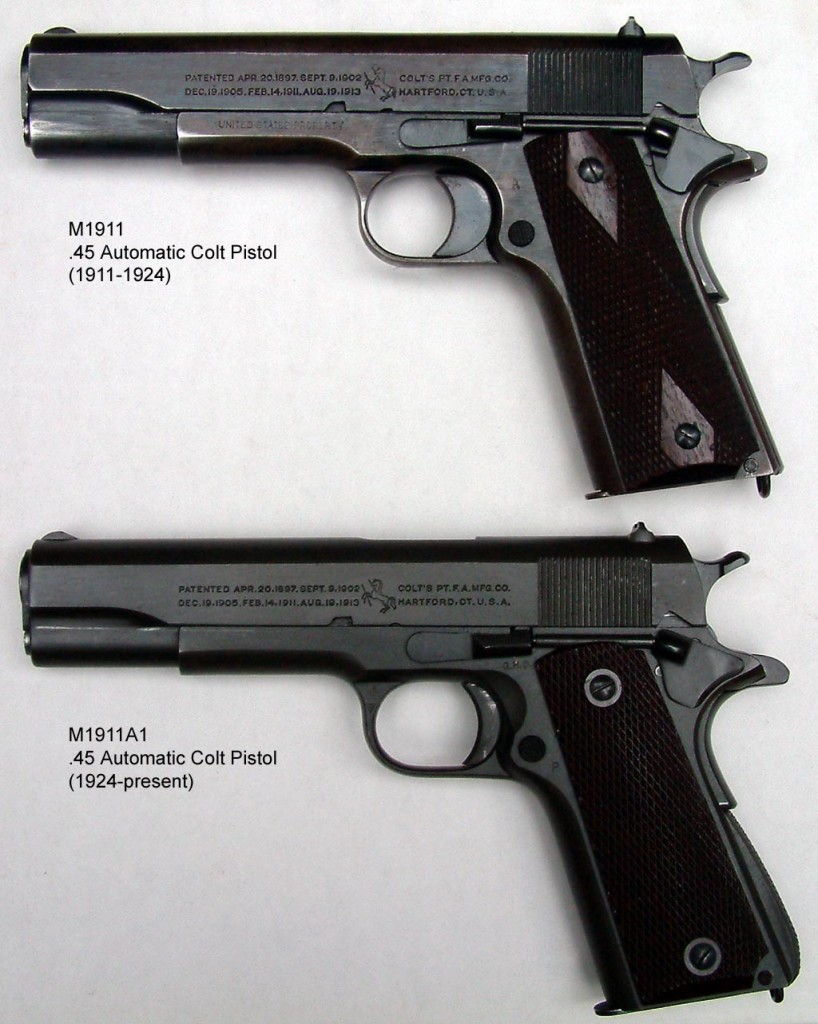
What To Expect
When opting for a 1911, you’re buying a 100 year old design. This does not mean the design itself is irrelevant or bad, merely that it will take a certain approach and recognition of inherent flaws in the design when it comes to maximizing the utility of the weapon.
Caliber Introduction
The modern 1911 platform comes in a variety of calibers, ranging from the standard ‘Big Three’ to more specialized calibers that have not been widely adopted and probably require a reloading setup to take advantage of. In this section I’ll be summarizing both the popular cartridges available for the design as well as some of the newer, boutique ones for more niche purposes. All magazine comments are geared toward people buying the single stack 1911 models, since the various double stack models have their own quirks and differences.
- .22LR (Long Rifle): A very handy training cartridge, this round is widespread and generally fairly cheap to acquire. There are 1911s chambered in .22LR as well as .22LR conversion kits for 1911s that modify the barrel and internal parts to account for the lower pressure and operating force of this cartridge. There are also .22LR pistols designed to look like a 1911 on the outside, but have even more significant differences in the internal workings and will operate differently than a 1911 chambered in .22LR.
- .45ACP: The cartridge the 1911 was originally designed for, this venerable round has been in service since the introduction of the handgun more than a century ago. Ballistics-wise, this cartridge is big and relatively slow. However, the in-depth discussion of it in relation to the rest of the ‘Big Three’ is a discussion for another day, though for a short introduction, you can check out our discussion of the ‘Big Three’ in our ZAUF series. In terms of magazine capacity, the original standard was seven rounds, with more modern standards set at 8, or if one is willing to use an extended magazine, 10. Of note, however, is that in a traditional 1911 chambered in .45 ACP, constant chambering and rechambering of the same round will result in bullet setback - when the bullet itself is pushed deeper into the brass from where it was originally seated. Cartridges suffering from bullet setback are dangerous to fire and should be removed from use.
- .45 Super: A cartridge design based off of the .45 ACP, .45 Super has the same external measurements, but with thicker walled brass that is loaded to higher pressure specifications, making it a more powerful round. Some, but not all, 1911s that are chambered in .45 ACP are also rated for .45 Super firing. It is up to the owner to check with the individual manufacturers to see if their 1911 is rated to handle .45 Super.
- 9x19mm Luger/Parabellum: With the rise in popularity of the cartridge itself as well as the adaptation of the M1911’s design, the 9mm cartridge works well on the platform and has been adopted in wider use by competition shooters and people looking to shoot a different caliber out of the 1911 platform. Magazine capacity for a standard 9mm model is about 10 rounds in a flush fit magazine, and more for extended magazines. In the author’s opinion, if you want a 9mm pistol and a Browning design, buy a Hi Power.
- .38 Super: A popular competition cartridge that traces its roots back to a drawing board in Colt’s factory, this cartridge is actually surprisingly powerful for the amount of attention it doesn’t receive. Ballistically, when using the right loads this cartridge overpowers 9mm Luger and can give .357 SIG a run for its money. If you’re buying a gun in this cartridge, you probably don’t need me to tell you how great it is. Good luck in IPSC.
- .357 SIG: This caliber is great - a solution to a problem that may or may not have existed - and has been adopted by a number of agencies including the Secret Service. However (and this is a rather large ‘however’), I do not believe the .357 SIG has any place in serious use with an M1911. With the .40 casing, this caliber only offers an absolutely minimal magazine capacity increase when compared to .45 ACP. It can also present issues caused by the necked casing. In short, if you want a gun in .357 SIG, the 1911 is not the best option.
- .40 S&W: A fairly popular cartridge used by law enforcement after the FBI decided 10mm was too powerful for them, this cartridge has a reputation of being a legitimate compromise between 9mm and .45ACP while also being Short(er) and Weak(er) than its 10mm parent cartridge (in all seriousness, the S&W stands for Smith & Wesson). From a practical standpoint, while you can buy a gun in this caliber, I never recommend it.
- 10mm: An interesting cartridge designed by Col. Jeff Cooper (who deserves a discussion in another article) in an effort to transcend the original pitfalls of the .45 ACP cartridge. This particular cartridge shoots flatter, farther, and is more powerfully than any of the ‘Big Three’ at the cost of increased recoil and in the current market, being significantly more expensive to purchase. So if you want a 1911 in 10mm, be sure you can handle the recoil, and be prepared to pay the price of ammunition.
- 7.62x25mm Tokarev: Actually a fairly rare find, there are conversion kits available for 9mm caliber M1911s that involve changing out the entire upper assembly (slide, barrel, bushings, etc.) and magazine to accept the elongated Russian ammunition. 7.62x25mm Tokarev is fast and cheap, so if the cost of ammunition is a concern, it might be worth considering.
- .400 Cor-bon: A more modern innovation focused on getting the ballistics of 10mm while still using the .45 ACP brass. This is a wildcat cartridge (meaning it is not mass produced and is not necessarily readily available) and is expensive to purchase in relation to the others on this list.
- .50 GI: A very niche wildcat round that boasts a larger diameter and improved ballistics over the .45 ACP cartridge. As of this writing, it is purely a novelty that provides the satisfaction of having a larger bullet that hits a little harder.
Grip Safety
The grip safety is the lever-like protrusion at the rear of the pistol frame that is held up against the web of the firing hand and needs to be fully depressed for the pistol to fire. In theory, under stress the grip safety will be depressed because the firing hand will have an adrenaline-fueled vice grip on the pistol and won't be an issue that requires discussion. However, after over 100 years of observation, there have been a number of incidents in which someone with a hand wound was unable to make the handgun function under stress due to being unable to deactivate the grip safety. Many consider this particular pitfall of the design to be one of the major downsides of the 1911 platform.
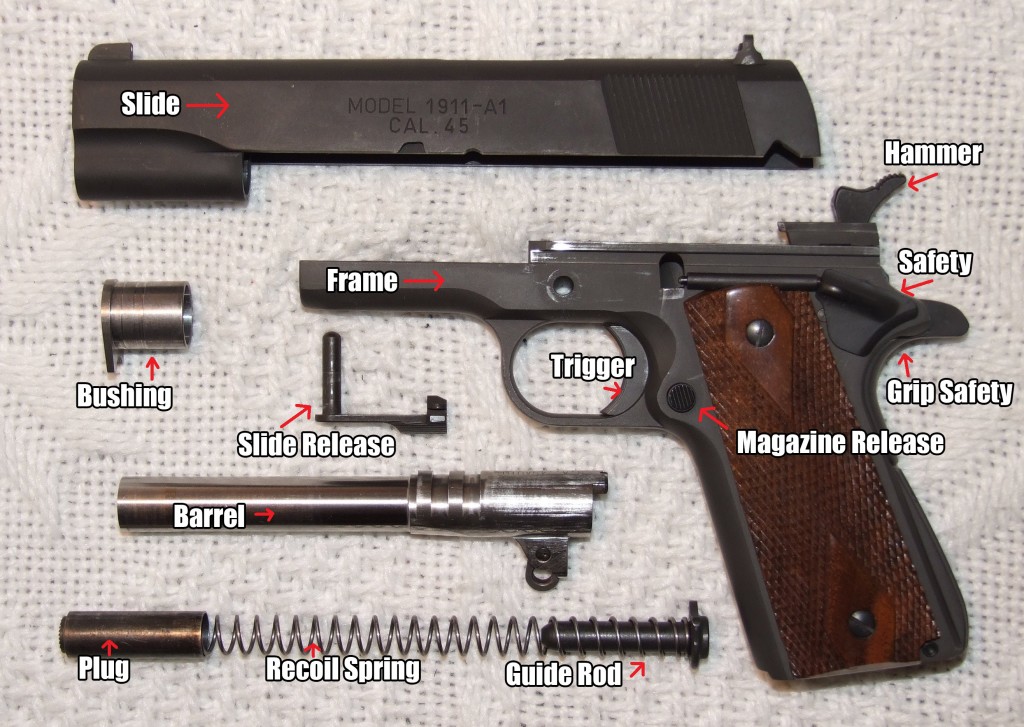
It is of my opinion that the 1911 design is the only one that can get away with having a grip safety since modern handguns that lack the sliding trigger or the particular safety/sear combination of the original design have no reason to even consider it (looking at you, HS2000/Springfield XD.) Furthermore, the original design of the pistol lacks a firing pin safety of any sort, leaving the grip safety and manual safety as the only 'safety' features on the firearm. The 1911 is a single action handgun, meant to be carried 'cocked and locked', meaning that the hammer is locked back and there is a round in the chamber.
The grip safety, the manual safety, and not pulling the trigger are the triad of conditions preventing the firearm from being negligently discharged. As a worst case scenario, if the manual safety lever is deactivated, the grip safety and absence of trigger pull are still there to prevent the gun from firing. Removing the grip safety from the single action only design only increases liability and potential hazard of misuse.
The single action only configuration is the confounding factor, with even some of the more poorly made 1911s having a relatively light and short trigger pull. That tradeoff is made for exactly those reasons, without the longer and heavier trigger characteristics of a modern design, the individual operator is able to shoot the pistol more precisely and consistently than its competitors.
Controls
As stated above, the original design of the 1911 comes with a manual safety lever that must be flipped down to fire the weapon. This safety lever interacts with the sear and hammer assembly to physically prevent the movement of the trigger to the rear as well as preventing the hammer from falling onto the firing pin. The original design of the lever is rather small and many modern designs have improved upon it with extended safety levers as well as adding the option to also have a lever on the right side of the pistol to make the weapon suitable for ambidextrous use. As a personal recommendation, unless you want a true to life replica of the older designs, the extended safeties are worth every additional penny.
Barrel
The M1911 bears a slightly different terminology when it comes to the size of the frame and length of the barrel between different models. It is understood if you refer to the different sizes by their more universal terms such as 'Full size', 'Compact', and 'Subcompact', but the specific vocabulary for the M1911 is as follows:
- Long Slide: Generally a barrel 6 inches or longer with a full sized frame, these are aptly named because these particular models generally have a custom made slide to cover the additional barrel length. This particular barrel length is significantly more common in competition circles and Arnold Schwarzenegger movies.
- Government: A 5 inch barrel, generally considered the 'full size' version of the 1911. This particular length is the one that was adopted for widespread service by the US Government and bears that title.
- Commander: A barrel about 4 inches long with shortened frame to match, this length is considered the 'compact' size of the M1911.
- Officer: The smallest of the lot, referring to a barrel approximately 3.5 inches long with an even more abbreviated frame. This length is considered the 'subcompact' size.
Trigger
The M1911 operates with a fairly unique trigger system uncommon in modern designs. Unlike other pistol designs, the trigger of the 1911 slides into the frame instead of hinging on a single point like a lever. This translates to a smoother, more consistently rearward trigger pull for the end user. This more 'luxurious' trigger pull benefits everyone from the most basic paper puncher all the way up to professional shooting competitors with highly tuned raceguns, which continues to drive the popularity of the platform.
Furthermore, the actual face of the trigger itself comes with various textures and geometry. The original design geometry of the trigger is slightly curved in a half moon shape, but modern innovations have different trigger geometries ranging from differently angled curves all the way to straight, flat triggers. The face of the trigger itself also ranges anywhere from smooth to serrated in various granular densities meant to give the shooter better tactile detail and control of the trigger pull.
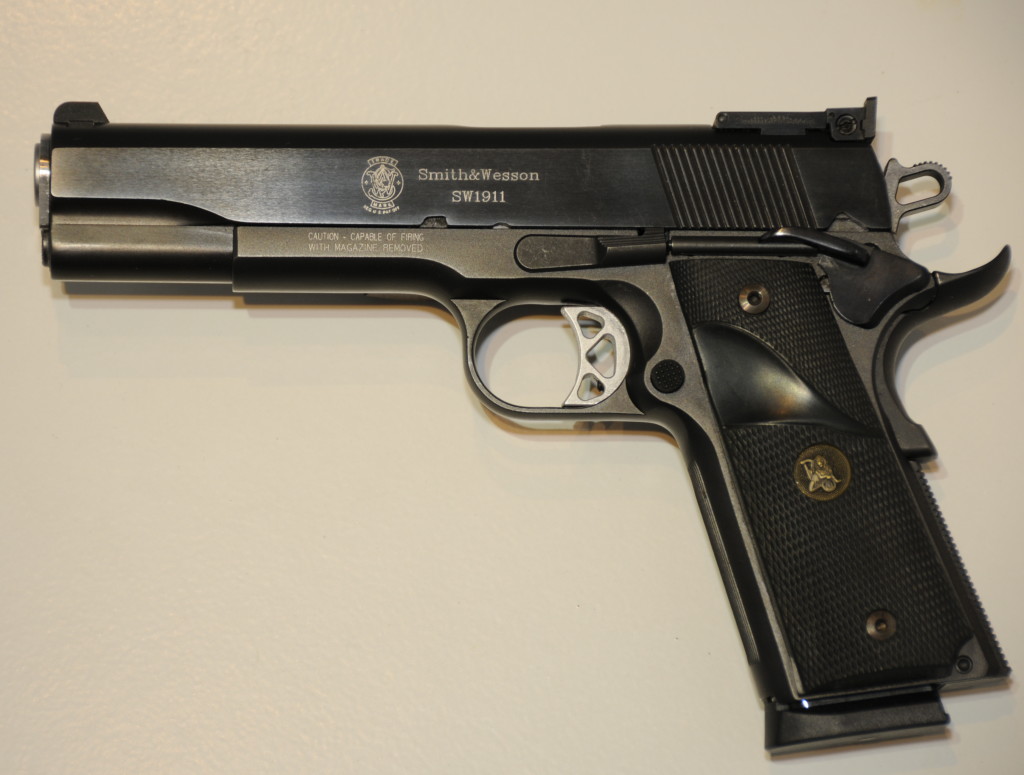
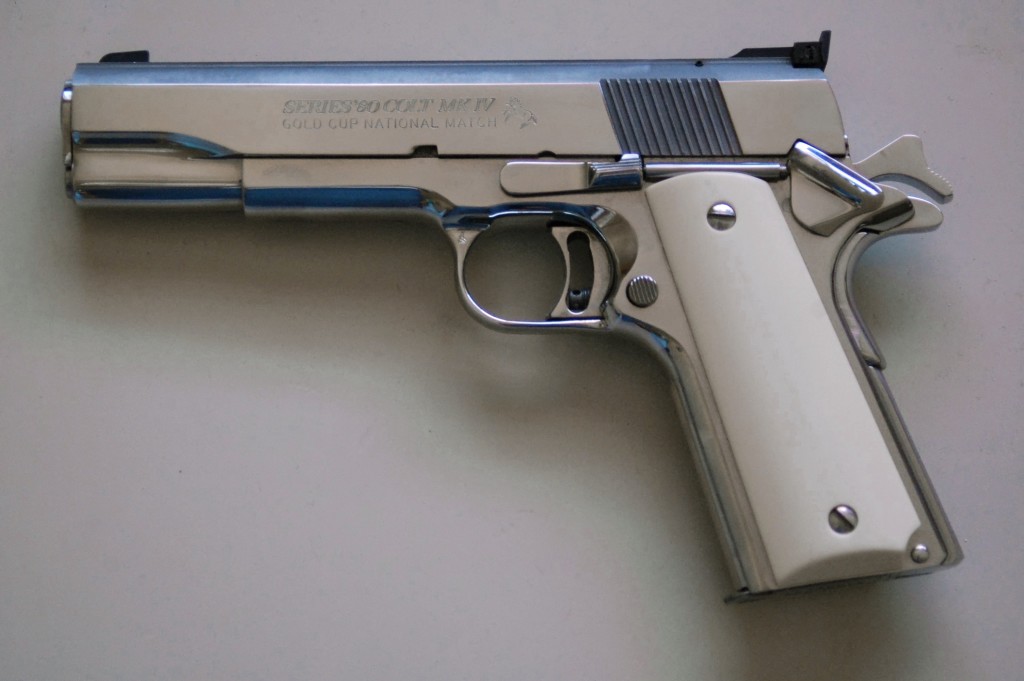
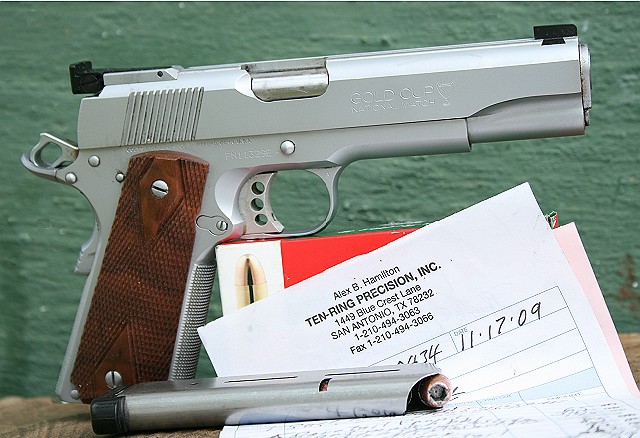
Single Stack Magazine
The original design of the 1911 comes with a single stack magazine. (For more on magazines, see our Zen and the Art of Understanding Firearms series here.) Additionally, the original design of the magazine had feed lips optimized for the 230 grain FMJ ball ammunition that was prevalent during the time period. (For a very detailed discussion on 1911 magazines, click here).
Modern 1911 magazine feed lips come in 3 broad categories: GI, Hybrid, and Wadcutter.
- GI spec magazine feed lips are designed solely for feeding FMJ ball ammunition (for more on bullet types, check out our ZAUF article here). The lips themselves are long and tapered toward the rear, maintaining full control of the cartridge through the entire firing and feeding cycle. This particular magazine type is actually fairly rare to find aftermarket and generally will only come in the 7 round capacity.
- Hybrid spec magazine feed lips allow the cartridge to spring free of the magazine's control earlier in the feeding cycle for the purpose of improving reliability in feeding non-hardball ammunition such as hollowpoints and wadcutters. The lips themselves are generally shorter while preserving the taper of their GI derivations.
- Wadcutter spec magazine feed lips are short and parallel, designed specifically for the wadcutter problem. Testing by the source cited above has shown that these short, parallel feed lips are a way to avoid double feeds when using rounds with a shorter overall length by way of preserving the intended feeding angle coming up out of the magazine.
Internal and External Extractors
A modern issue with the 1911 platform is the current implementation of various extractors. The original design of the 1911 stipulates an internal extractor and many purists will defend that decision to the death. However, opting for an internal extractor in a modern production pistol will entail a higher price tag due to the additional cost of fitting and finishing required to properly tune an internal extractor.
For anyone with any experience with modern handguns, an external extractor is par for the course: accessible visually from the outside of the pistol, in the production of a given firearm an external extractor is much easier to deal with and doesn't add any unforeseen costs to the production of the pistol. As it is with everything, mileage varied throughout some production models with various shifts in quality and reliability throughout the years, but modern production 1911s with external extractors will generally be reliable in their function.
Full Length Guide Rod
Referring once again to the original design of the 1911, the design required only a short rod tensioned with the mainspring against the recoil spring plug. A trend in modern 1911s has been to eschew that for an 'improved' design involving a two-piece full length guide rod that requires a tool (usually a hex wrench of some variety) to remove it from the frame. What many manufacturers will promise from this change in design is an inherent increase in accuracy for the weapon. From personal experience and the majority of anecdotes available for public perusal, there is no real evidence to support that statement beyond marketing hype. As a rule, I do not recommend opting for a full length guide rod in a 1911 purchase because it will only add unnecessary complexity without any added function.
Barrel Bushings
The 1911 is fairly unique in the field of modern production handguns due to the fact that it uses a removable barrel bushing. The barrel bushing is the piece at the front of the slide that surrounds the barrel, keeping it in place during the operation of the weapon as well as providing the cap which holds in the recoil spring and plug.
A few modernized designs will instead utilize a bull barrel (which is thicker than a standard barrel) that eliminates the need for the barrel bushing but requires the full length guide rod described above.
Aside from aesthetic reasons, the only reason to acquire these particular types of modernized designs is for competition purposes, and if you’re building a racegun you probably already know what you want out of your pistol and this guide is probably too basic for your needs.
Series 70 vs Series 80 1911s and the Firing Pin Block
The original design of the 1911 did not incorporate a firing pin block. For the uninitiated, a firing pin block is a safety system that prevents the firing pin from accidentally activating on anything short of having the trigger pulled, usually at the cost of changing the actual feel of the trigger pull itself.
The colloquialism used in the subsection involves the Colt manufacturing series of 1911s, the Series 70 models being made in the original style without the firing pin block and the Series 80 being made with a firing pin block.
As with most colloquialisms, this is not an entirely accurate description of the true difference between the 70 and 80 Series of guns, but in common parlance the lack or presence of the firing pin block is enough to cover the topic conversationally. For a more in depth discussion of this topic click here
As far as the practical concerns of the firing pin block, there will be a difference in the feel of the trigger pull when there is a firing pin block present. Usually this difference is described as being heavier and grittier, getting in the way of target trigger performance. However, if you’re willing to spend the money to get a trigger job done by a good gunsmith, the presence of the firing pin block will be a non-issue. However, the firing pin block is not required by the design in order for the firearm to be considered safe, as the existing safeties and mechanics of the gun are enough to prevent an accidental discharge. The firing pin block adds another layer of safety that the individual can opt for if they like.
Controlled Feed Principle
Simply put in this write-up the cartridge must remain in full control of the pistol from the time the magazine is locked in place to when the spent casing clears the ejection port. Once again referring to the original design of the M1911 platform, with GI spec magazines and the full metal jacket ammunition that the pistol was designed to use, this principle is held true through the entire loading/firing/ejection/feeding cycles.
Modern improvements and changes simply add another (or multiple other) dimension of issues to consider during the microseconds of ejecting, feeding, and chambering. The trend away from the GI spec magazine lips takes away from the full control of the cartridge during the feeding cycle in favor of entrusting proper chambering to the forward momentum of the new cartridge rather than pressure applied during the feeding cycle.
Commercial Production
For general consumer purposes, the available firearms on the market can be separated into five broad tiers based almost entirely on cost:
- Budget: This tier is dominated by the Philippine import companies such as Rock Island Armory and American Tactical Imports. The price range starts relatively low and is capped at about $600. Many of these companies are able to provide a decent product that may have more modernized amenities and features than their higher priced counter parts by taking advantage their location and labor costs to lower their prices.
- Basic Commercial Production: This tier of production involves many commercial brands that lack the higher end features and hand fitting of their premium counterparts, but generally tend to be made in the US and come with quality guarantees as well as the custom shop capability to back their promises up. The general price range involved in this tier is anywhere from $600-$850
- Premium Production: The luxury tiers of the commercial brands, these pistols are made from the same production parts as their basic brethren but spend a brief period in each company’s custom shop for some hand fitting and finishing. The general price range of this tier will run from $850-$1200.
- Semi-Custom: Generally a very high end tier of pistol that has the option of being made to order and begin their lives entirely in the care of the company’s custom shop, these pistols receive extra care and quality control from beginning to end of their production cycle. The price range on these pistols will run generally from $1500-$3000
- Custom: At this tier, you’re no longer dealing with commercial production, but instead generally with small custom shops and individual gunsmiths. These pistols are made to order to individual specifications and requirements and exist in a tier generally from $3000+.
Building a 1911
Some people will want to take on the project of building a 1911 from ‘scratch’, or hand fitting together parts from a premade slide, receiver, and barrel kit. I cannot express how strongly I advise against this particular course of action if you have no previous machining experience. While relatively simple in theory, there is a reason why gunsmithing is considered a professional trade that requires specialized tools. For a vast majority of people, the endeavor will be filled with nothing but pain and frustration.
However, if you are completely insistent on building a 1911 from a parts kit for yourself, read this as a way of familiarizing yourself with the process from start to finish.
The Round-Up
To reiterate the point, if after reading this guide and doing your own additional research you’re still unsure as to what to get, buy a $650-$1200 pistol chambered in .45 ACP with a Government length (5”) barrel from Springfield Armory, Colt, Smith & Wesson, SIG Sauer, Ruger, or Remington. A decent pistol from a major brand will minimize the frustration and hassles of the platform while maximizing the shooting experience.
The 1911 platform is second only to the AR-15 in modern firearms in terms of the amount of variety and options available for purchasing and customization. For the average consumer, this can present a mind boggling set of choices that may not always make sense. Hopefully this guide has helped to clarify the features and choices available.

